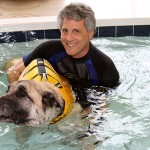Rehabilitation for Peroneus Tertius Rupture (Solange Mikail)
View Full Poster Here
Mikail, S; Stancov, L.Y.; Lopes, A.
Espaco Equus- Brazil
INTRODUCTION
A 17-years Old Lusitano horse was evaluated at Espaco Equus Rehabilitation Center after a nine months history of rest due to a rupture of the Peroneus tertius in the left hind limb. Ultrasound examination at arrival showed an enlargement of the Peroneus tertius near its origin, with hypoechoic areas and diffuse edges. A biomechanical evaluation was performed with an app (Hudi Thecnique) for smart phones, developed for measure angles during exercise. The angle of the left tarsus in maximal flexion was 140 degrees.
OBJECTIVE
The goal was to reeestablish the ability to flex the left tarsus.
MATERIAL AND METHODS
Two treatments were implemented: Therapeutic Laser (Respond Systems Luminex®) 20 J/cm2 to address the healing of the lesion and a program of exercises with progressive intensity to address the flexion of the tarsus and strengthening of the limb. The exercises consisted in stimulation of the tarsal flexion, using different techniques during one month: whip, handwalking, ridden exercise, tactile stimulation of the pastern. walking over poles, cavalettis and kinesiology taping (VetkinTape®) during exercise.

RESULTS AND DISCUSSION
After 30 days, the ultrasound examination showed the Peroneus tertius with normal size and echogencity and also with well defined edges. The biomechanical evaluation showed that the maximum flexion angle of the hock at walk improved from 140 degrees to 57 degrees. According to the literature (Koenig, 2005), the lesion of the Peroneus tertius takes several months to heal, and when is near its origin, it carries a poor prognosis. Despite the poor prognosis for the lesion site, this case had an excellent outcome in a short time.
CONCLUSION
This rehabilitation protocol resulted in an excellent outcome in a short time (one month), considering the previous longtime of rest without evolution (nine months). It also highlights the value of adding a program of therapeutic exercises during the healing of this type of injury.
REHABILITATION PROTOCOL

REFERENCES
KOENIG J, CRUZ A, GENOVESE. R, etal. Rupture Peroneus tertius tendon in 27 horses. The Can vet Journal p. 503-506 Jun 2005
CLAYTON HM; KAISER LA, STUBBS NC. Hindlimb flexion responses to different types of tactile devices. Am J Vet Res 72: 1489-1495. Jan 2011




